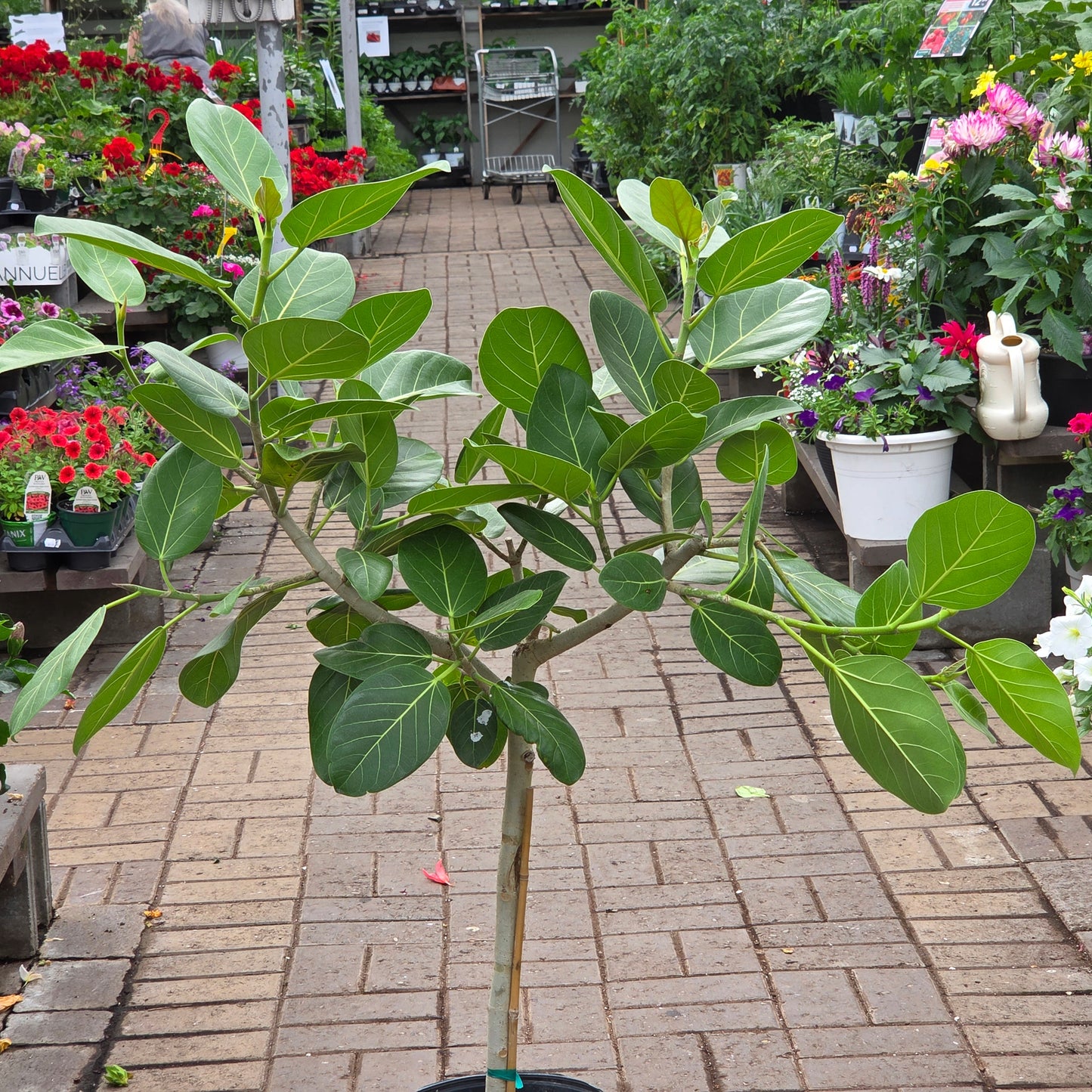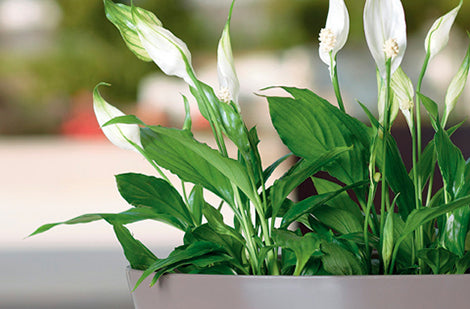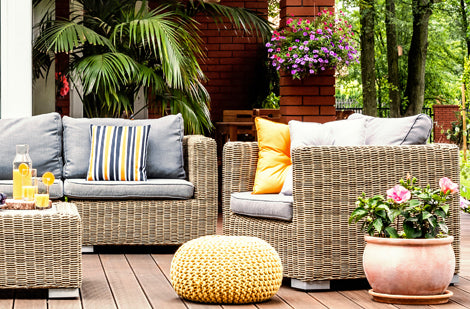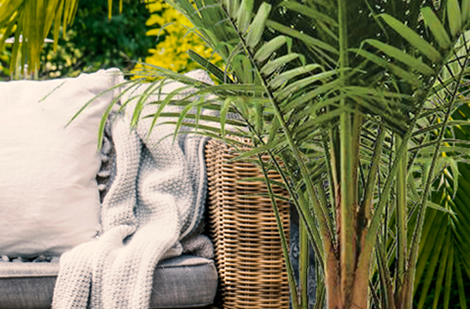Ficus benghalensis 'Audrey'
Ficus benghalensis 'Audrey' – Ficus Audrey Standard
Ficus benghalensis 'Audrey' – Ficus Audrey Standard
Exposure
- Bright indirect light
Rusticity
- Velvety, sage-green foliage
- Elegant indoor tree silhouette
- Prefers bright, indirect light
- Helps purify indoor air
- Perfect as a "feature" plant
Ficus benghalensis 'Audrey', presented here in its standard (tree) form, is a majestic and trendy houseplant. Valued for its elegant, tree-like silhouette and distinctive foliage, it brings a sophisticated touch of nature and an impressive focal point to any decor. Less fussy than its popular cousin, the Fiddle Leaf Fig, it is an excellent choice for greening an indoor space.
Characteristics
- Foliage: The leaves are large, oval-shaped, and a beautiful sage green. Their velvety, almost downy texture is unique and soft to the touch. The foliage is evergreen, ensuring a green presence year-round.
- Flowering: Flowering is non-existent or very rare in indoor conditions and has no ornamental value.
- Light: It thrives in an environment with bright, indirect light. It can tolerate a few hours of direct morning or late afternoon sun, but avoid harsh afternoon sun which could burn its leaves. A slightly veiled south or west-facing window is ideal.
- Habit: Its "standard" form gives it an upright, tree-like habit. It consists of a straight, clear trunk topped with a dense, rounded crown of foliage, creating the look of a true indoor tree.
- Growth: Moderate. In a pot indoors, it can reach a height of 1.5 to 3 metres (approximately 5 to 10 feet). Its size is easily controlled by pruning and pot size.
- Humidity: It appreciates high ambient humidity but adapts well to standard household levels. Keep it away from drafts and heating vents. Browning leaf edges can indicate the air is too dry.
- Soil: A rich, well-draining potting soil for houseplants is recommended. A mix of potting soil, perlite, and sand ensures a good balance of moisture retention and aeration.
- Temperature: Normal room temperatures, between 18 and 25 degrees Celsius, are perfect. Avoid exposing it to temperatures below 18 degrees Celsius.
- Watering: Keep the soil consistently moist, but never soggy. Allow the top 5 to 7 cm (2-3 inches) of soil to dry out between waterings. Prolonged under-watering can cause leaf drop, while over-watering can lead to root rot.
- Pests: It is susceptible to sap-sucking insects like mealybugs, scale, and aphids. Good hygiene (dusting the leaves) helps prevent their appearance.
Uses
- Types of Use: Grown exclusively in a container as a houseplant. It is perfect as a "feature" plant in a bright living room, office, or entryway to create a strong visual impact.
- Ornamental Features: Its sculptural, tree-like habit provides a striking vertical element. The contrast between its light-coloured trunk and its velvety, sage-green foliage adds rich texture and a sense of calm and elegance to any room.
- Summer Outdoors: To stimulate its growth, Ficus 'Audrey' can be moved out to a patio from mid-June to late August. It must be gradually acclimatized and placed in a bright location, but sheltered from direct afternoon sun and strong winds.
Care
- Fertilizing: Fertilize once a month from spring to early fall with a balanced liquid fertilizer for houseplants. Stop fertilizing during the winter.
- Pruning: Prune in spring or summer to maintain the crown's shape, control height, and encourage denser branching. The plant secretes a milky, sticky sap when cut; it is advisable to protect surfaces.
- Repotting: Repot every 2 to 3 years, or when the plant becomes root-bound (roots growing through the drainage holes). Choose a pot about 5 cm (2 inches) wider in diameter.
Plant details
Dimensions
Dimensions
Characteristics
Characteristics
Habit:
Flowering colours:
Plant needs
Plant needs
Watering:
- Tolerates moist soil
Maintenance:
- Medium
- Fertilize regularly
- Prune in spring
Soil requirement:
Features
Features
Resistance:
Attract:
Use:
Attribute:
- Evergreen


Related articles
-

Potting House Plants: which pot to choose
Read the articleBien qu'une plante puisse passer plusieurs mois et parfois même plusieurs années dans le même pot, avec le temps ses racines envahissent tout l'espace disponible. Il devient important de choisir...
-

Moving Up a Level: Advanced Guide to Repotting ...
Read the articlePropagate your violets! Discover the simple cutting method, the secret to the perfect soil mix, and how to fight mealybugs.
-

The Complete Guide to Buying and Caring for Ind...
Read the articleBringing a touch of nature to your home with plants is a great idea! Not only do they beautify your living space, but they also help purify the air. However,...
-

Build Your Own Terrarium: The Complete, Easy Gu...
Read the articleThe terrarium is the perfect addition to your decor! Learn how to easily create your own miniature garden with our complete guide.
-

Create a garden with succulents
Read the articleLes plantes grasses n’ont pas leur pareil pour créer des arrangements à la fois impressionnants par leurs couleurs, leurs formes et leurs textures et faciles à entretenir. Qu’on les agence...
-

Houseplants to discover - Butterfly Palm or Are...
Read the articleDypsis lutescens, anciennement Chrysalidocarpus lutescens
-

Calathea: The Essential Guide to Mastering the ...
Read the articleCalathea is a stunning addition, but it's demanding! The key to its success? Humidity. Find out why tap water and dry air are its worst enemies and how to give...
-

Jade Plant (Crassula): The Easy-Care Succulent ...
Read the articleThe jade plant is a must-have! Learn all the secrets to caring for this resilient succulent that naturally grows into an elegant miniature tree.
-

Madagascar Dragon Tree: Embrace Effortless, Gra...
Read the articleAdd a modern touch to your home! The Madagascar Dragon Tree is low-maintenance, perfect for beginners, and stands out with its slender look and two-toned foliage.
-

Aspidistra: The "Cast Iron Plant" Indestructibl...
Read the articleDon't have a green thumb? The Cast Iron Plant is for you! Tolerant of shade and missed waterings, it's perfect for lobbies and offices. Learn how to maintain its leathery...
-

Embrace the Fern: The Champion of Shade and Tro...
Read the articleGot a dark corner? Ferns are your allies! They are easy to care for if you master one factor: humidity. Learn how to water them perfectly for spectacular and full...
-

-

Kalanchoe: The Secret to Massive Blooms That La...
Read the articleNeed lasting colour? The Kalanchoe blooms profusely for over two months! An easy succulent that tolerates neglect and adds a vibrant touch to your home.
-

Snake Plant: The Unkillable Houseplant, Perfect...
Read the articleThe Snake Plant is an ideal houseplant for everyone, whether you're a beginner or an experienced gardener. Its resilience, ease of maintenance, and decorative appearance make it an essential choice...
-

Edible Flowers: Top 5 for Garden and Kitchen
Read the articleOffrant une belle gamme de couleurs, de formes et de textures, les fleurs comestibles enthousiasment les amoureux de jardinage et de cuisine.
-

Tropical Flowering Plants: A touch of the exoti...
Read the articleLes plantes tropicales à fleurs ont tout pour faire tourner les têtes! Colorées, odorantes, généreuses, elles n’ont pas leur pareil pour égayer une aide de repos, un balcon, une terrasse....
-

Keep a palm tree on the terrace - why not!
Read the articleDifficile de résister à l’appel des tropiques quand le soleil et les températures clémentes se pointent le bout du nez. Rien de mieux qu’un palmier sur la terrasse ou le...
-

Bring Your Plants Indoors for Winter: The Compl...
Read the articleDon't get caught by the first frost! Prepare your outdoor plants for winter with our complete guide.
-

When and how to repot house plants
Read the articleAlthough a plant can spend several months and sometimes even several years in the same pot, over time its roots invade all the available space.
-

Choosing the best potting soil for your indoor ...
Read the articleDon't let your plants stall: learn how to choose the ideal potting mix and optimize drainage for vibrant foliage.



























